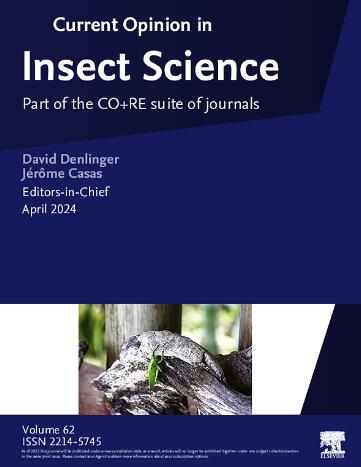驱虫剂为什么能驱虫?
IF 5.8
1区 农林科学
Q1 BIOLOGY
引用次数: 0
摘要
人类和动物都使用驱虫剂来保护自己免受叮咬,它们还有助于控制病媒传播疾病。世界上有许多天然和合成的化学制剂以及电子设备在市场上销售,据称它们可以提供个人保护,防止昆虫叮咬。但并非所有驱虫剂都能提供真正有效的保护,它们对人类、动物或环境也不安全。目前迫切需要找到新型、无毒和环保的替代品。然而,目前在这方面的努力面临着一个重大障碍:我们对它们如何驱赶蚊子和其他叮咬性节肢动物的了解仍然不全面。DEET 也是如此,它是驱虫剂的 "黄金标准",自 20 世纪 40 年代被发现以来使用最为广泛。本文旨在通过讨论我们现有的知识和未来的需求,为寻找新的驱蚊剂提供指导。本文章由计算机程序翻译,如有差异,请以英文原文为准。
Why do repellents repel?
Repellents are used by humans and by animals to protect themselves from bites, and they contribute controlling the transmission of vector-borne diseases. There are numerous chemical formulations of both natural and synthetic origins, as well as electronic devices, that are commercially available worldwide alleged to provide personal protection against insect bites. Not all insect repellents are effective enough to provide real protection, nor are they considered safe for humans, animals or the environment. There is an urgent need to find novel, nontoxic and environmentally friendly alternatives. However, current efforts in this direction face a major obstacle: our understanding of how they keep away mosquitoes and other biting arthropods remains incomplete. This is also true for DEET, the ‘gold standard’ of repellents and the most widely used since its discovery in the 1940s. This article aims to guide the search for new repellents by discussing our current knowledge and future needs.
求助全文
通过发布文献求助,成功后即可免费获取论文全文。
去求助
来源期刊

Current opinion in insect science
BIOLOGYECOLOGYENTOMOLOGY-ECOLOGY
CiteScore
10.40
自引率
1.90%
发文量
113
期刊介绍:
Current Opinion in Insect Science is a new systematic review journal that aims to provide specialists with a unique and educational platform to keep up–to–date with the expanding volume of information published in the field of Insect Science. As this is such a broad discipline, we have determined themed sections each of which is reviewed once a year.
The following 11 areas are covered by Current Opinion in Insect Science.
-Ecology
-Insect genomics
-Global Change Biology
-Molecular Physiology (Including Immunity)
-Pests and Resistance
-Parasites, Parasitoids and Biological Control
-Behavioural Ecology
-Development and Regulation
-Social Insects
-Neuroscience
-Vectors and Medical and Veterinary Entomology
There is also a section that changes every year to reflect hot topics in the field.
Section Editors, who are major authorities in their area, are appointed by the Editors of the journal. They divide their section into a number of topics, ensuring that the field is comprehensively covered and that all issues of current importance are emphasized. Section Editors commission articles from leading scientists on each topic that they have selected and the commissioned authors write short review articles in which they present recent developments in their subject, emphasizing the aspects that, in their opinion, are most important. In addition, they provide short annotations to the papers that they consider to be most interesting from all those published in their topic over the previous year.
 求助内容:
求助内容: 应助结果提醒方式:
应助结果提醒方式:


